Daikon grater
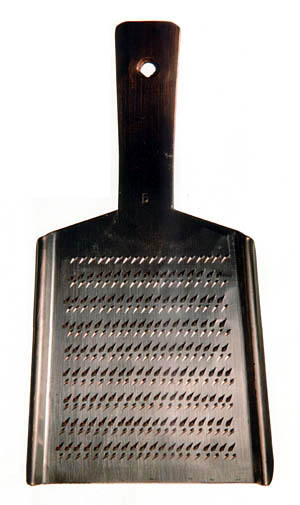
Oroshigane are used to grate daikon radish and mountain potato, as well as ginger and wasabi. This copper oroshigane is the standard shape, though they are made in many sizes.
Copper is the most suitable material for the oroshigane - ensuring that the teeth will be neither too hard nor soft. For copper graters like this one, a thin copper sheet is first pounded with a spring hammer to strengthen the metal before being cut by hand into the classic shape.
After being plated in tin, the teeth are then cut and raised tooth by tooth - a painstaking job still done by hand. (Any handmade grater with worn teeth can be refurbished.)
Wasabi grater
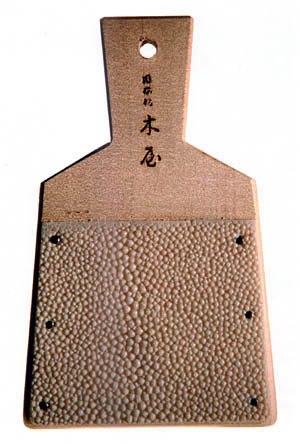
This oroshigani is used almost exclusively to grate wasabi, the pungent yet sweet "horseradish" that complements sushi and other dishes. It consists simply of a piece of sharkskin nailed to a natural wood board.
Sharkskin has been used in Japan for centuries, most notably in sword grips, and here its rough texture - similar to the coarsest sandpaper - makes for a finer grating surface than metal graters provide.
Many chefs believe that metal is too harsh for grating wasabi; others say the extra pressure needed to grate on sharkskin does a better job of releasing wasabi's volatile flavor.
Crane-shaped grater
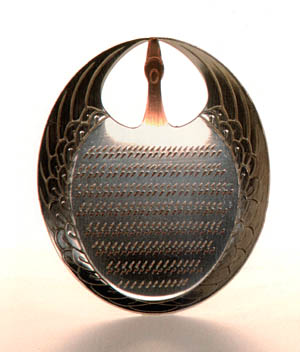
Imagine having this individual grater, or yakumi oroshigane, topped with a stick of fresh wasabi, brought to your table so that you might grate relish for your soba noodles.
While the craftsman took great care with the aesthetics (making this a most covetable object!), he also considered the diner's comfort. The handcrafted, tin-coated copper crane, which symbolizes good luck and long life, is designed to nestle in the palm of the hand, making grating much easier than if it were the standard utensil, which is held by the end.
Turtle-shaped grater
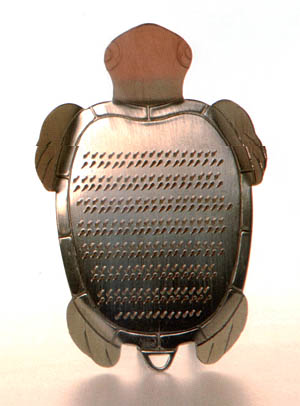
From the same craftsman as the "crane" grater above, form and function also abound in this turtle: its head raised as a grip for the user, its tail serving as a loop for hanging in the kitchen. These graters embody the spirit of omotenashi - the idea of gracious hospitality carried out effortlessly.
It's no coincidence that the craftsman chose these two animals. The crane is said to live a thousand years, the turtle ten thousand. Representing both long and prosperous lives, they are often used as symbols on celebratory occasions.
Graters are available at Kiya in Tokyo: www.kiya-hamono.co.jp.
Source Notes
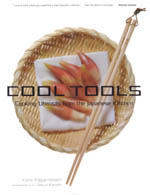
Reprinted with permission from the book:
Cool Tools: Cooking Utensils from the Japanese Kitchen
Kodansha International
Japanese cuisine is flourishing among the food-conscious all over the world - as are the recipe-laden cookbooks. Now, this book goes inside the kitchen, but this time into the cupboards and drawers, onto stovetops and wall hangers where all sorts of utensils, pots and pans are stored. Here are the items that are manipulated in the hands of the famous in their awe-inspiring kitchens - and the not-so-famous in their homes.
As with so many Japanese creations, the utensils that stock a Japanese kitchen are both functional and artistic. And the pieces that are the focus of this book are treated as both works of art and items of practical interest. This is a book for the professional chef and the curious amateur, a perfect addition to the well-stocked cookbook library.
ISBN4-7700-3016-9
Y2800
- Order this book from amazon.com
- Order this book from amazon.co.jp (in Japan)
- Find this book at your local English-language bookstore in Japan
- Or use the ISBN to order from your local bookstore.
More articles
- © Copyright Lobster Enterprises
- Privacy
- Bento.com top
- © Copyright Lobster Enterprises
- Privacy
- Bento.com top
- © Copyright Lobster Enterprises
- Privacy
- Bento.com top







